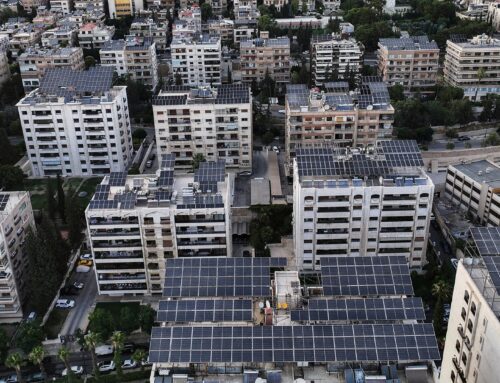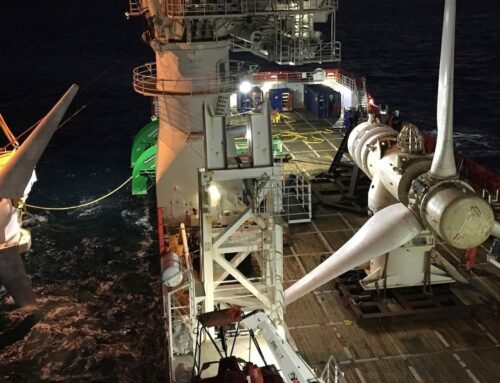Is wind power finally coming to Maine’s remote north?
July 7, 2025

Two years after the last attempt to build out wind farms in Maine’s northern reaches fizzled, the state is again gearing up to seek developers to build at least 1,200 megawatts of land-based wind capacity and a transmission line to carry the electricity produced to the central part of the state. At the same time, grid operator ISO New England is accepting proposals for new transmission infrastructure that will allow that power to flow to the rest of the region.
For wind power advocates, these moves have sparked hope that a new source of renewable energy may finally be developed in the region.
“After talking about this for the last 15 years, I feel like there’s a light at the end of the tunnel,” said Francis Pullaro, president of clean-energy industry association RENEW Northeast. “It’s definitely complicated and a big undertaking, but I think the state has realized what a great opportunity northern Maine wind provides.”
Maine and most of its neighboring states have ambitious emissions-reduction targets: Maine just adopted legislation calling for 100% clean energy by 2040, for example, and Massachusetts and Rhode Island both aim to be carbon-neutral by 2050. Offshore wind has been a major part of the states’ strategies for transitioning away from a system that now leans heavily on natural gas for electricity generation. However, as the Trump administration throws up roadblocks to offshore wind development, it becomes even more important to tap into land-based wind to keep progressing toward a cleaner energy future, supporters said.
“It’s a really important medium-term piece of the puzzle in how we reduce our dependence on gas as a region and for our state,” said Jack Shapiro, climate and clean energy director for the Natural Resources Council of Maine, an environmental advocacy group. “It’s a pretty big deal.”
Plans to build onshore wind in northern Maine’s remote Aroostook County have come and gone several times over the past two decades. In 2008, then-Gov. John Baldacci (D) signed a law setting a goal of bringing 2,000 MW of wind power online by 2015 and 3,000 MW, including some offshore wind, by 2020. As of this year, the state has 1,139 MW of onshore wind operational and no offshore turbines.
Aroostook County — with its strong winds and low population density — has long been considered a prime area for building turbines, but its promise has not been realized. One of the major obstacles has been the lack of transmission lines to carry power from the forests of northern Maine to the lightbulbs and dishwashers of Massachusetts and Connecticut. Most of Aroostook County is served by an electrical system connected only to Canada, with no direct links to any U.S. power grid. Building the needed lines is a complex, costly undertaking that has repeatedly stymied efforts to get wind generation up and spinning.
“For the southern New England states where all the load is, [northern Maine] always was a fairly distant resource,” Pullaro said. “The lack of transmission has always been the barrier.”
In 2013, Connecticut selected a planned wind development in Aroostook County — EDP Renewables’ Number Nine Wind Farm — to provide 250 MW of power to the state. By the end of 2016, the project had been cancelled, with EDP citing the lack of transmission capacity to get the electricity to customers farther south.
In the final days of 2022, Massachusetts agreed to buy 40% of the power generated by the proposed King Pine wind farm in Aroostook County, a deal that seemed to give the 1,000-MW project the financial security it needed to proceed. By the end of 2023, however, a separate agreement with LS Power to build a transmission line connecting the development to the rest of New England fell through over pricing disagreements, undermining the prospect of wind development.
“The contract negotiations were not successful, and the project stalled,” said Dan Burgess, director of the Maine Governor’s Energy Office.
Now the state has gone back to the drawing board. This time around, however, the plans are getting an unprecedented boost from ISO New England. The regional grid operator in late March issued a request for proposals for the development of a transmission project connecting the Maine town of Pittsfield to points farther south in New England, shortening the distance the power lines from future Aroostook County wind farms will have to travel. A plan could be chosen as soon as September 2026.
Meanwhile Maine utilities regulators released a request for information to collect feedback from developers, industry members, and other stakeholders to help plan and schedule its next procurement. There has been a robust response to the request, though most comments were filed confidentially, said Susan Faloon, spokesperson for the Maine Public Utilities Commission. The tentative plan is to open up for proposals by the end of the year, she said.
Whether the next attempt will be successful hinges on a few factors, starting with its ability to financially weather Republicans’ scaleback of federal clean-energy tax credits and the administration’s continued, evolving hostility to renewable energy projects. Trump halted federal permitting and leasing for wind projects on his first day in office, and although 99% of onshore wind farms are built on private property, they still could need environmental permits from the administration.
“The economics of any specific project is really uncertain right now because we don’t know what will happen,” Shapiro said.
Still, Pullaro said, history suggests that onshore wind development could survive the blow of losing federal support. The grid needs more energy, and land-based wind is one of the least expensive power sources to build, even without incentives, while the cost of new natural gas generation is going up, according to a recent report from investment bank Lazard.
“From the industry point of view and for consumers, wind is still a good deal no matter where the tax situation is,” Pullaro said.
Tweaks to the state’s timeline for issuing a request for proposals and choosing a project could also increase the likelihood of success, Pullaro said. A wind development stands a much better chance of succeeding, he said, if another state commits to buying power from it, giving it a revenue stream it can count on. Getting Massachusetts on board could be even more crucial than federal support, he said.
Massachusetts is still authorized to enter into another such agreement until the end of the year, and Gov. Maura Healey (D) included in a supplemental budget bill a provision that would extend this authorization to 2027, but the legislation is still pending. In the meantime, if Maine waits until the end of 2025 or into 2026 to launch a new solicitation, the eventual development could lose its chance to secure a deal with Massachusetts. Pullaro, therefore, would like to see Maine issue a request for proposals by September.
“The economics don’t work for Maine going it alone,” he said.
Sarah Shemkus
is a reporter at Canary Media who is based in Gloucester, Massachusetts, and covers New England.
Search
RECENT PRESS RELEASES
Related Post



